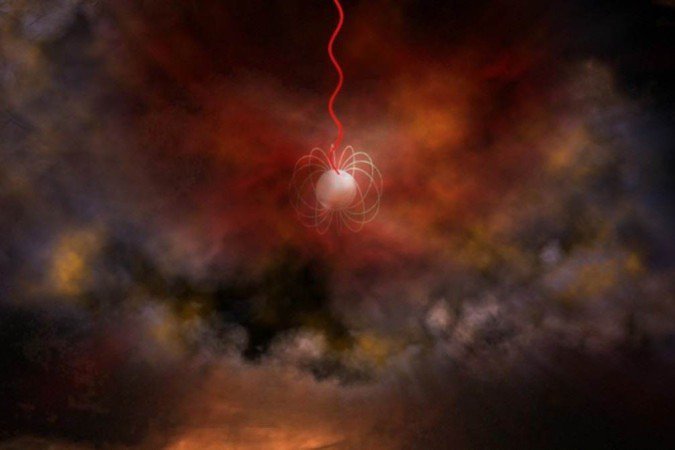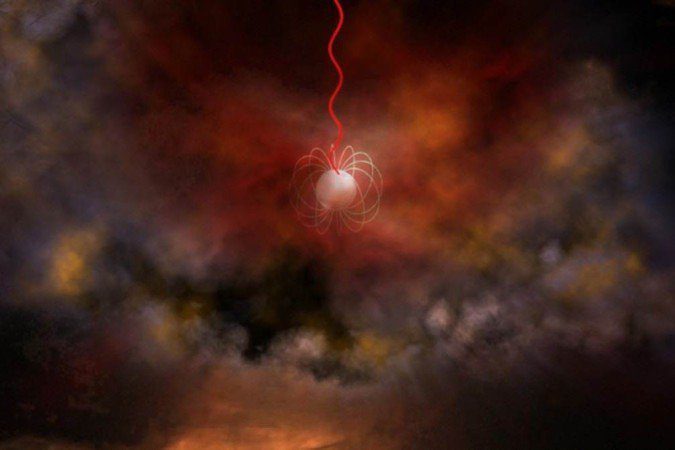Astronomers detect repeated bursts of radio waves in space
3 min read
Published on 06/08/2022 21:28 / Updated on 06/08/2022 21:36

(Credit: BILL SAXTON, NRAO/AUI/NSF)
Astronomers have found the second example of fast radio bursts (FRBs) in history. The event calls into question the nature of mysterious space phenomena. The explosions are intense and by short flashes of radiofrequency emissions, which last for milliseconds.
This phenomenon was first discovered in 2007 by graduate student David Narkevich and became known as “Lorimer Burst”. The source of these high-energy events is a mystery, but clues to their nature are gathered through repetition.
The FRB is a transient radio pulse that varies in length by a fraction of a millisecond milliseconds, due to some mysterious, high-energy astrophysical process that has yet to be discovered. Astronomers estimate that the average FRB releases the same amount of energy in one thousandth of a second (one thousandth of a second) as the Sun does in 3 days (which is about 250,000 seconds).
The new discovery raises new questions about the nature of these mysterious objects and also about their usefulness as tools for studying the nature of intergalactic space.
The new source was detected using the Five Hundred Meter Aperture Spherical Radio Telescope (FAST) in Guizhou, China, in 2019. The discovery was spotted by the Jansky Very Large Array (VLA) program in 2020. Led by Caltech, the group was able to On determining the location of the object, this allowed the observation of visible light using the Subaru telescope in Hawaii to show that it is located on the outskirts of a dwarf galaxy about 3 billion light-years from Earth.
The VLA’s observations also found that the body consistently emits weaker radio waves between bursts.
To the National Astronomical Observatories of China (NAOC), De Li, head of the Rapid Survey of Communal Radio Astronomy (CRAFTS), which discovered the FRB in China, confirmed that the bigger question is where the eruptions come from. “One of the key questions in the field of FRBs is whether or not all sources are repeating themselves.”
Another special feature, the researcher explains, is the wave scattering measurement, which indicates that the emission passed through the highest electron density of any FRB before it was observed on Earth. This indicates that FRB is active in a local plasma environment, such as that generated by a supernova, a newly created source.
While providing insight into the FRB environment, the wide discrepancy in the dispersal measurements with other FRBs calls into question their use as ‘cosmological standards’ for measuring distances.
Franz Kirsten, a postdoctoral researcher at the Netherlands Institute for Radio Astronomy (ASTRON) said: space.com That it would be possible to trace an evolutionary path of fast radio bursts, but with these two sources alone it is difficult to determine. “We need to find more and constrain this evolutionary phase model. We really need more (radio bursts) at different ages to say OK, this thing disappears all the time. So what would be really cool to see is if these static sources actually disappear with the time “
Co-author Yu Wenfei said space.com “The mechanisms responsible for measuring the additional scattering and quasi-source ecology of such frequent FRBs with PRS association remain problematic. But I am optimistic that the FRB puzzle will be resolved by investigating such extreme FRBs,” Yu said.
This is why it is so valuable to discover more frequent FRB sources, along with trying to get a much better picture of the environments in which they occur, for example using the Hubble Space Telescope to follow up on observations.
* Trainee under the supervision of Pedro Gregory.

“Musicaholic. Thinker. Extreme travel trailblazer. Communicator. Total creator. Twitter enthusiast.”









